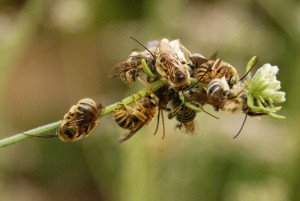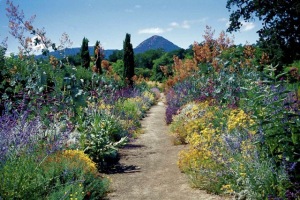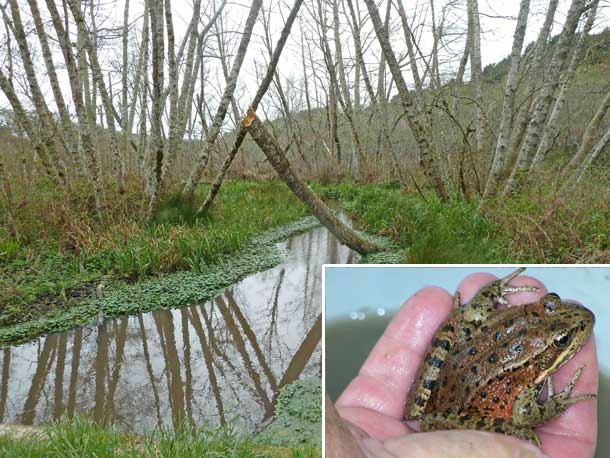Walk around your garden this spring and see for yourself what’s happening; bees are everywhere. I’m not just talking about the familiar honeybee, Apis mellifera, which, since its introduction to North America 380 years ago, has become synonymous in the public’s mind with “bee.” Look a little closer and you’ll notice an assortment of bees that don’t quite look like those familiar Italian imports. These are California’s native bees, busy collecting pollen and nectar from every imaginable floral resource in a drive to provide offspring with enough food to grow up strong and replace them the following spring. California, with its vast assemblage of more than 5,000 native plants, has an impressive diversity of native pollinating bees—more than 1,500 known species. Here in the Bay Area we can expect to see at least 75 of these.
Anyone who has ever kept honeybees knows they are fair-weather pollinators and sloppy ones at that. Cloud cover and cool temperatures send them buzzing back to the hive for shelter. They will visit nearly every flower regardless of whether it has already been pollinated. But when conditions are right, 15,000 workers streaming out of the hive can do a lot of pollinating in a short period of time; hence their value as crop pollinators and honey producers.
- Xylocopa tabaniformis takes nectar from a monkeyflower (Mill Valley). Photo by Edward Ross.
Unlike the honeybee, most native bees are solitary species that do not form huge colonies with discrete divisions of labor. They may nest communally where habitats are prime, but they go about their work primarily as individuals sharing a common resource. What the honeybees provide through sheer volume, the native bees provide in efficiency. Since native bees evolved in concert with our flora over the millennia, their peak of activity coincides with the bloom cycles of native flowers and shrubs. Some pollinate specific types of plants, or even particular plant species.
Besides pollinating flowers, trees, and shrubs, native bees are themselves food for a wide range of other wildlife. Lizards, dragonflies, bats, mantids, frogs, toads, assassin bugs, spiders, songbirds, and other bees and wasps feed on them. Unlike colonial nesters such as honeybees and wasps, which have much more to lose, solitary bees rarely sting potential predators (including humans).
Native solitary bees fall into four general categories: ground nesters, leafcutters, cavity nesters, and masons. Ground nesters excavate burrows in sandy soil or cliff banks. Leafcutters excise semicircular swatches of leaf material, which they fashion into a cylindrical vessel to hold the pollen cake upon which they lay their egg. Cavity nesters use beetle emergence holes in trees, the hollow stems of plants, crevices under bark, and even the furrows of the chiseled epitaphs on cemetery headstones. Mason bees collect pollen and pack it into natural cavities before laying a single egg on the pollen loaf. The cavity is then sealed off from predators and the elements with a mud plug. Mason bees are also readily attracted to artificial nest boxes, as are native bumblebees. Bumblebees, which nest colonially, are extremely efficient pollinators, visiting only unpollinated flowers and “working” even in low temperatures and light rain.
Recent research has shown that native bees prefer native plants when given the choice, though most species are able to feed on introduced species as well. In monitoring done on garden plots in the East Bay, bees were observed to prefer native plants over exotic ornamentals by a ratio of four to one. Not surprising, given that many horticultural varieties of landscape plants have been selected for their ability to produce showy blooms for us, the human purchaser, at the expense of nectar or pollen production. So they are less attractive to pollinators than the simple, natural structures of native plant blooms.
While nothing can replace the wildlands we have lost to development, backyard gardens can be good foraging habitat for our native pollinators. Indeed, recent investigations suggest that urban plantings can have a significant impact on the numbers and diversity of native bees. Dense stands of native flowering plants are particularly attractive to them, and patches of about 16 square feet are more desirable than isolated plantings here and there. Bees get more bang for the buzz when there are lots of flowers to visit in a small area; flying from plot to plot expends valuable energy and uses up fuel and time. Many solitary bees nest within 50 yards of their foraging sites, so providing artificial nest boxes near pollen sources will help to promote a healthy population of bees in your yard. In turn, bringing native bees into your surroundings will ensure a better fruit/seed set for your plants, give you hours of entertainment, and create a foundation for a healthy native landscape right outside your window.

.jpg)




-300x221.jpg)